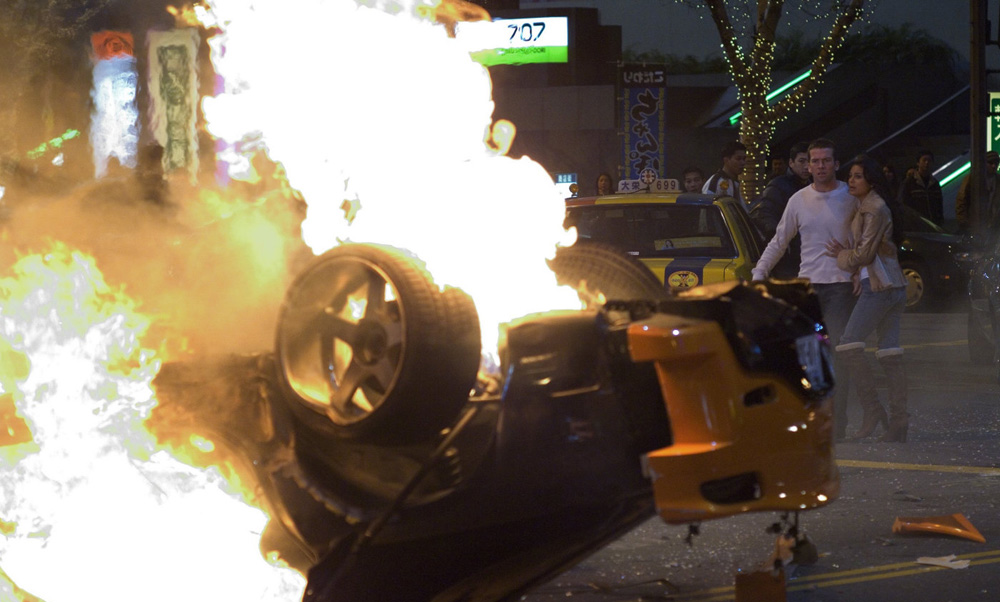“It’s a special movie,” Justin Lin said repeatedly throughout the nearly hourlong Q & A that followed a screening of “Fast and Furious: Tokyo Drift” last week in Los Angeles at the New Beverly Cinema. Shown as part of Marc Edward Heuck’s The Projector Has Been Drinking Cinema Tremens series, Lin had reason to marvel. In front of a room full of super fans such as moderator Jen Yamato of Deadline Hollywood and people who worked on the film including various FX artists, composer Brian Tyler, editor Fred Raskin and actress Nikki Griffin, Lin reflected on how shocking it was for the film to be made at all, given that he repeatedly passed on making “Tokyo Drift” and yet somehow found himself shooting it in October of 2004 in order to make a June 2005 release date, all while he was still in post-production on his first studio film “Annapolis.”
Even more unlikely, however, was the fact that “Tokyo Drift,” which felt as if it was the last gasp of a series that was running on fumes after abandoning its original stars Vin Diesel and Paul Walker for the lesser known Lucas Black and Bow Wow, was enough of a hit to renew the franchise, commercially and artistically. As his collaborators would attest, this was due in no small part of Lin’s tenacity once he did sign on as well as a lack of oversight, thanks to then-Universal studio chief Stacey Snider’s impending move to take over the same position at DreamWorks, that led to the success of what the director called “a big $80 million indie movie.” That was hardly the only number thrown around during the evening, but we kept a running tally of the fun facts for your perusal. Spoilers ahead.

When Griffin recalled how Bryan and Black actually did most of their own driving, Lin mentioned that originally he intended the scene to end with all three of the actors being thrown through the windshield of their respective cars and ending up floating in a manmade pond. “I’m really glad we didn’t do that,” said Griffin. Yet Lin was able to get his wish in “Fast Five” when Diesel and Walker were faced with jumping off a cliff. “I had this vault of all these ideas and eventually, I got to use them all up,” said Lin, who officially passed the series off to James Wan after “Fast & Furious 6.”

After also deciding that Han wouldn’t make it to the end of “Tokyo Drift,” Lin was pretty certain that he wouldn’t be making another “Fast” film, even after “Tokyo Drift” proved successful. But driving up from Los Angeles to take part in a parade in San Francisco after the film came out, Lin and Kang stopped at an Arby’s where Kang was mobbed by a group of Latino kids yelling “Han! Han!” Lin said, “I remember sitting there thinking, “Wow, there’s a connection. At that point, I told the studio I’m not interested in doing 4, but sitting there looking at him interacting with the kids, I just felt like it’s going to be really great to be able to evolve this and do everything we had talked about. So when I pulled [back on the highway], I called the studio and said I’m back in.”
4 – Hours Lin spent with Vin Diesel to convince him to make a cameo in “Tokyo Drift.” After Diesel notoriously turned down the opportunity to star in “2 Fast 2 Furious,” Lin was told “there’s no fucking way you’re getting Vin Diesel” for “Tokyo Drift.” However, Lin and Universal exec Jeffrey Kirschenbaum were undeterred in snagging him for the film’s final coda. As Lin remembered, “We talked our way to going to his house. I remember he was showing us his Dungeons and Dragons book and stuff like that and I ended up talking by his poolside for four hours about the mythology [of the series] and his relationship with Han. It sounds crazy, but all the way up to ‘Fast 6,’ a lot of that was talked about that night in 2005.” Cut to eight months later when they were testing the film for the first time, Lin said, “When Vin Diesel showed up, I remember sitting in the audience and the crowd went crazy and that’s when the studio went, ‘Wow, maybe we should bring him back.'”
That conversation actually might have been exceeded in length by another Lin and Diesel had on the set of “Fast Five.” When someone in the audience brought up how the fight between Diesel’s Dom and Dwayne Johnson’s Luke Hobbs was a favorite, Lin said it took him five hours to talk Diesel into throwing his elbow at Johnson because he was having an issue with it. Says Lin, “I sent the whole crew home and I talked to him about that elbow. Not just that elbow, but how every shot and every hit was important. It was great because Vin is like family and I can share that story because sometimes in situations like that, it’s like ‘Oh, it’s an elbow, let’s go to the next thing.’ But the fact that it took five hours of really talking to him not only about the elbow, but the history of the elbow, the tension of the elbow and the mythology of the elbow, that was the level I wanted to engage.”
6 – Times someone went to jail for Lin while shooting in Tokyo. Film permits weren’t an option for the production since they don’t grant them in Tokyo, so Lin had to run-and-gun in the city, particularly any time he filmed at the famously busy intersection Shibuya Crossing. The crew learned they’d have about 20 minutes of shooting time before police would arrive to stop filming and when the police would ask who was the director, one member of the crew (who would also play the bathhouse attendant in the film) made it his job to announce himself as the director so he would be carted off for a night in jail instead of Lin. “He was the Japanese me,” said Lin.

7 – Days after “Fast 5” opened that editor Raskin was hired by Quentin Tarantino to edit “Django Unchained.” Following the untimely passing of Sally Menke, who had edited all of his films since “Reservoir Dogs,” Tarantino was looking into the possibility of hiring Raskin, her assistant editor on “Kill Bill” who had since come up in the ranks working with Lin from “Annapolis” on. Raskin recalled how he got the “Django” script four days before “Fast 5” and while he was still on the mix stage, putting together the extended cut of the film with Lin, Tarantino e-mailed him telling him that he would be spending the day watching “Tokyo Drift” and “Fast and Furious.” That wasn’t the end of it. Recalled Raskin: “I remember showing Justin Quentin’s e-mails as they came in, like after he watched “Tokyo Drift” and after he watched “Fast and Furious” and he was like, “So wait a minute, ‘Tokyo Drift’ takes place after the beginning of “Fast and Furious,” but then the rest happens after…? Then he went to a midnight show of “Fast Five” and it was the next week he told me he wanted me to do the movie, so these movies were my audition.”

Lin’s answer: “I had never done any action movies [before] and I was trying to break it down, like how do I talk to the actors and how do I design these [races]? I remember breaking them down as a short film and really going through the motivations. By skills, [the film’s villain] DK should always win, but this kind of goes back to Han’s comment, “Why do you race?” It has to be worth something more than just winning the race. So I think on the day when I was talking to Brian [Tee, who played DK] and Lucas [Black], it became very obvious that the one guy that was going to lose always checks out who he’s racing versus the obstacle of the race itself.”





Comments 2